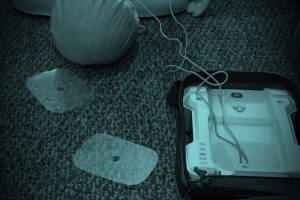
Sudden cardiac arrest (SCA) during sports events has a dramatic impact on stadium-goers and the public and is often associated with poor outcomes unless treated with an automated external defibrillator (AED). Despite this, stadiums vary in AED use. This review aims to identify the risks and incidences of SCA, and the use of AEDs in soccer and basketball stadiums. A narrative review of all relevant papers was conducted. Athletes across all sports face an SCA risk of 1:50,000 athlete-years, with the greatest risk of SCA in young male athletes (1:35,000 person-years) and black male athletes (1:18,000 person-years). Africa and South America have the poorest soccer SCA outcomes at 3% and 4% survival. AED use on-site improves survival greater than defibrillation by emergency services. Many stadiums do not have AEDs implemented into medical plans and the AEDs are often unrecognizable or are obstructed. Therefore, AEDs should be used on-site, use clear signaling, have certified trained personnel, and be incorporated into stadiums’ medical plans.
For full study click below;






